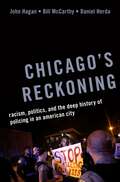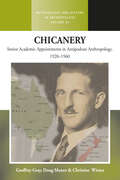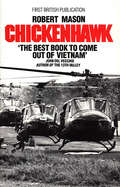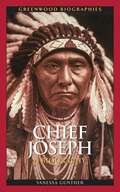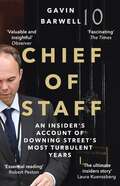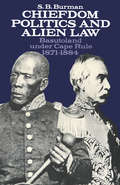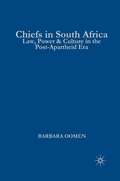- Table View
- List View
Chicago's Reckoning: Racism, Politics, and the Deep History of Policing in an American City
by John Hagan Bill McCarthy Daniel HerdaA searing examination of the long history of police misconduct and political corruption in Chicago that produced the city's current racial reckoning Chicago faces a racial reckoning. For over 50 years, Chicago Mayors Richard J. and Richard M. Daley were at the helm of a law-and-order dynasty that disadvantaged predominantly Black and Brown neighborhoods and covered up heinous crimes against Black men. During his 1980-2012 tenure as State's Attorney and Mayor, Richard M. Daley (son of Richard J. Daley) led a law enforcement bureaucracy which permitted police detective John Burge to supervise the torture of over 100 Black men on Chicago's South and West Sides. Misguided policies on "gangs, guns, and drugs," support for a racialized code of silence and police misconduct, and a lack of meaningful punishment, have ensured that these leaders' effects on Chicago are still sorely felt. In this book, John Hagan, Bill McCarthy, and Daniel Herda confront the complicated history of race, politics, and policing in Chicago to explain how crime works from the top-down through urban political machines and the elite figures who dominate them. The authors argue that the Daleys' law enforcement system worked largely to benefit and protect White residential areas and business districts while excluding Black and Brown Chicagoans and concentrating them in highly segregated neighborhoods. The stark contradiction between the promise "to serve and protect" and the realities of hyper-segregation and mass incarceration created widespread cynicism about policing that remains one of the most persistent problems of contemporary Chicago law enforcement. By holding a sociological lens up to the history of this quintessential American city, Chicago's Reckoning reveals new insights into the politics of crime and how, until we come to terms with our history and the racial and economic divisions it created, these dynamics will continue to shape our national life.
Chicago's Reckoning: Racism, Politics, and the Deep History of Policing in an American City
by John Hagan Bill McCarthy Daniel HerdaA searing examination of the long history of police misconduct and political corruption in Chicago that produced the city's current racial reckoning Chicago faces a racial reckoning. For over 50 years, Chicago Mayors Richard J. and Richard M. Daley were at the helm of a law-and-order dynasty that disadvantaged predominantly Black and Brown neighborhoods and covered up heinous crimes against Black men. During his 1980-2012 tenure as State's Attorney and Mayor, Richard M. Daley (son of Richard J. Daley) led a law enforcement bureaucracy which permitted police detective John Burge to supervise the torture of over 100 Black men on Chicago's South and West Sides. Misguided policies on "gangs, guns, and drugs," support for a racialized code of silence and police misconduct, and a lack of meaningful punishment, have ensured that these leaders' effects on Chicago are still sorely felt. In this book, John Hagan, Bill McCarthy, and Daniel Herda confront the complicated history of race, politics, and policing in Chicago to explain how crime works from the top-down through urban political machines and the elite figures who dominate them. The authors argue that the Daleys' law enforcement system worked largely to benefit and protect White residential areas and business districts while excluding Black and Brown Chicagoans and concentrating them in highly segregated neighborhoods. The stark contradiction between the promise "to serve and protect" and the realities of hyper-segregation and mass incarceration created widespread cynicism about policing that remains one of the most persistent problems of contemporary Chicago law enforcement. By holding a sociological lens up to the history of this quintessential American city, Chicago's Reckoning reveals new insights into the politics of crime and how, until we come to terms with our history and the racial and economic divisions it created, these dynamics will continue to shape our national life.
Chicanery: Senior Academic Appointments in Antipodean Anthropology, 1920–1960 (Methodology & History in Anthropology #44)
by Geoffrey Gray Doug Munro Christine WinterAcademic appointments can bring forth unexpected and unforeseen contests and tensions, cause humiliation and embarrassment for unsuccessful applicants and reveal unexpected allies and enemies. It is also a time when harsh assessments can be made about colleagues’ intellectual abilities and their capacity as a scholar and fieldworker. The assessors’ reports were often disturbingly personal, laying bare their likes and dislikes that could determine the futures of peers and colleagues. Chicanery deals with how the founding Chairs at Sydney, the Australian National University, Auckland and Western Australia dealt with this process, and includes accounts of the appointments of famous anthropologists such as Raymond Firth and Alexander Ratcliffe-Brown.
Chicanery: Senior Academic Appointments in Antipodean Anthropology, 1920–1960 (Methodology & History in Anthropology #44)
by Geoffrey Gray Doug Munro Christine WinterAcademic appointments can bring forth unexpected and unforeseen contests and tensions, cause humiliation and embarrassment for unsuccessful applicants and reveal unexpected allies and enemies. It is also a time when harsh assessments can be made about colleagues’ intellectual abilities and their capacity as a scholar and fieldworker. The assessors’ reports were often disturbingly personal, laying bare their likes and dislikes that could determine the futures of peers and colleagues. Chicanery deals with how the founding Chairs at Sydney, the Australian National University, Auckland and Western Australia dealt with this process, and includes accounts of the appointments of famous anthropologists such as Raymond Firth and Alexander Ratcliffe-Brown.
The Chicano Movement: Perspectives from the Twenty-First Century (New Directions in American History)
by Mario T. GarcíaThe largest social movement by people of Mexican descent in the U.S. to date, the Chicano Movement of the 1960s and 70s linked civil rights activism with a new, assertive ethnic identity: Chicano Power! Beginning with the farmworkers' struggle led by César Chávez and Dolores Huerta, the Movement expanded to urban areas throughout the Southwest, Midwest and Pacific Northwest, as a generation of self-proclaimed Chicanos fought to empower their communities. Recently, a new generation of historians has produced an explosion of interesting work on the Movement. The Chicano Movement: Perspectives from the Twenty-First Century collects the various strands of this research into one readable collection, exploring the contours of the Movement while disputing the idea of it being one monolithic group. Bringing the story up through the 1980s, The Chicano Movement introduces students to the impact of the Movement, and enables them to expand their understanding of what it means to be an activist, a Chicano, and an American.
The Chicano Movement: Perspectives from the Twenty-First Century (New Directions in American History)
by Mario T. GarciaThe largest social movement by people of Mexican descent in the U.S. to date, the Chicano Movement of the 1960s and 70s linked civil rights activism with a new, assertive ethnic identity: Chicano Power! Beginning with the farmworkers' struggle led by César Chávez and Dolores Huerta, the Movement expanded to urban areas throughout the Southwest, Midwest and Pacific Northwest, as a generation of self-proclaimed Chicanos fought to empower their communities. Recently, a new generation of historians has produced an explosion of interesting work on the Movement. The Chicano Movement: Perspectives from the Twenty-First Century collects the various strands of this research into one readable collection, exploring the contours of the Movement while disputing the idea of it being one monolithic group. Bringing the story up through the 1980s, The Chicano Movement introduces students to the impact of the Movement, and enables them to expand their understanding of what it means to be an activist, a Chicano, and an American.
Chichester in the 1960s
by Alan H.J. GreenChichester is the archetypal Georgian town, with streets of elegant buildings gathered closely around the ancient cathedral. It usually appears to today’s first-time visitor that the city has been largely untouched by the hand of time – particularly the destructive hand that guided the 1960s. However, this is not the case: in the 1960s, Chichester faced the same challenges as all historic towns, and much was lost – but the brakes were applied in good time and it became one of the first conservation areas in the country. This book, the first of its kind, looks at how Chichester fared in that turbulent decade, how it gained its status as a city of culture with a new theatre and museum, and how it expanded to meet the demands of its growing populace. Historical research blends with personal anecdote to produce a heartfelt portrait of the decade.
Chick Flicks: Contemporary Women at the Movies
by Suzanne Ferriss Mallory YoungFrom An Affair to Remember to Legally Blonde, "chick flicks" have long been both championed and vilified by women and men, scholars and popular audiences. Like other forms of "chick culture," which the editors define as a group of mostly American and British popular culture media forms focused primarily on twenty- to thirtysomething, middle-class—and frequently college-educated—women, chick flicks have been accused of reinscribing traditional attitudes and reactionary roles for women. On the other hand, they have been embraced as pleasurable and potentially liberating entertainments, assisting women in negotiating the challenges of contemporary life. A companion to the successful anthology Chick Lit: The New Woman’s Fiction, this edited volume consists of 11 original essays, prefaced by an introduction situating chick flicks within the larger context of chick culture as well as women’s cinema. The essays consider chick flicks from a variety of angles, touching on issues of film history, female sexuality (heterosexual and homosexual), femininity, female friendship, age, race, ethnicity, class, consumerism, spectatorship, pleasure and gender definition. An afterword by feminist film theorist Karen Hollinger considers the chick flick’s transformation from the woman’s films of the ’40s to the friendship films of the ’80s and those of the "return to the classics" trend of the ’90s, while highlighting the value of the volume’s contributions to contemporary debates and sketching possibilities for further study.
Chick Flicks: Contemporary Women at the Movies
by Suzanne Ferriss Mallory YoungFrom An Affair to Remember to Legally Blonde, "chick flicks" have long been both championed and vilified by women and men, scholars and popular audiences. Like other forms of "chick culture," which the editors define as a group of mostly American and British popular culture media forms focused primarily on twenty- to thirtysomething, middle-class—and frequently college-educated—women, chick flicks have been accused of reinscribing traditional attitudes and reactionary roles for women. On the other hand, they have been embraced as pleasurable and potentially liberating entertainments, assisting women in negotiating the challenges of contemporary life. A companion to the successful anthology Chick Lit: The New Woman’s Fiction, this edited volume consists of 11 original essays, prefaced by an introduction situating chick flicks within the larger context of chick culture as well as women’s cinema. The essays consider chick flicks from a variety of angles, touching on issues of film history, female sexuality (heterosexual and homosexual), femininity, female friendship, age, race, ethnicity, class, consumerism, spectatorship, pleasure and gender definition. An afterword by feminist film theorist Karen Hollinger considers the chick flick’s transformation from the woman’s films of the ’40s to the friendship films of the ’80s and those of the "return to the classics" trend of the ’90s, while highlighting the value of the volume’s contributions to contemporary debates and sketching possibilities for further study.
Chickamauga 1863: The river of death (Campaign)
by James ArnoldBy the Autumn of 1863 the Confederacy was in dire straits. In a colossal gamble, Confederate President Jefferson Davis stripped forces from all the major Confederate armies to reinforce the Army of Tennessee in a last ditch attempt to crush the Union. On 19th September the Confederates attacked the Union army along Chickamauga creek south of Chattanooga. On the second day of bloody fighting the entire Union right collapsed and the army retreated headlong for Chattanooga, all except General George H. Thomas' Corps who fought on doggedly until nightfall delaying the confederate advance, saving the Union and earning his fame as the "Rock of Chickamauga".
Chickamauga 1863: The river of death (Campaign)
by James ArnoldBy the Autumn of 1863 the Confederacy was in dire straits. In a colossal gamble, Confederate President Jefferson Davis stripped forces from all the major Confederate armies to reinforce the Army of Tennessee in a last ditch attempt to crush the Union. On 19th September the Confederates attacked the Union army along Chickamauga creek south of Chattanooga. On the second day of bloody fighting the entire Union right collapsed and the army retreated headlong for Chattanooga, all except General George H. Thomas' Corps who fought on doggedly until nightfall delaying the confederate advance, saving the Union and earning his fame as the "Rock of Chickamauga".
Chickamauga 1863: Rebel Breakthrough (Battles and Leaders of the American Civil War)
by Alexander MendozaReleased to mark the 150th anniversary of one of the bloodiest battles of the Civil War, this book provides general readers with a succinct examination of the Confederacy's last major triumph.There is renewed interest among Civil War historians and history buffs alike about events west of the Appalachian Mountains and their impact on the outcome of the conflict. In examining the Chickamauga campaign, this book provides a fresh analysis of the foremost Confederate victory in the Western theater. The study opens with a discussion of two commanders, William S. Rosecrans and Braxton Bragg, and the forces swirling around them when they clashed in September 1863. Drawing on both primary sources and recent Civil War scholarship, it then follows the specific aspects of the battle, day by day.In addition to interweaving analysis of the Union and Confederate commanders and the tactical situation during the campaign, the book also reveals how the rank and file dealt with the changing fortunes of war. Readers will see how the campaign altered the high commands of both armies, how it impacted the common soldier, and how it affected the strategic situation, North and South.
Chickamauga 1863: Rebel Breakthrough (Battles and Leaders of the American Civil War)
by Alexander MendozaReleased to mark the 150th anniversary of one of the bloodiest battles of the Civil War, this book provides general readers with a succinct examination of the Confederacy's last major triumph.There is renewed interest among Civil War historians and history buffs alike about events west of the Appalachian Mountains and their impact on the outcome of the conflict. In examining the Chickamauga campaign, this book provides a fresh analysis of the foremost Confederate victory in the Western theater. The study opens with a discussion of two commanders, William S. Rosecrans and Braxton Bragg, and the forces swirling around them when they clashed in September 1863. Drawing on both primary sources and recent Civil War scholarship, it then follows the specific aspects of the battle, day by day.In addition to interweaving analysis of the Union and Confederate commanders and the tactical situation during the campaign, the book also reveals how the rank and file dealt with the changing fortunes of war. Readers will see how the campaign altered the high commands of both armies, how it impacted the common soldier, and how it affected the strategic situation, North and South.
Chicken: A History from Farmyard to Factory (Environmental History)
by Paul R. JosephsonWhy has the chicken become the meat par excellence, the most plentifully eaten and popular animal protein in the world, consumed from Beijing to Barcelona? As renowned historian Paul Josephson shows, the story of the chicken's rise involves a whole host of factors; from art, to nineteenth-century migration patterns to cold-war geopolitics. And whereas sheep needed too much space, or the cow was difficult to transport, these compact, lightweight birds produced relatively little waste, were easy to transport and could happily peck away in any urban back garden. Josephson tells this story from all sides: the transformation of the chicken from backyard scratcher to hyper-efficient industrial meat-product has been achieved due to the skill of entrepreneurs who first recognized the possibilities of chicken meat and the gene scientists who bred the plumpest and most fertile birds. But it has also been forced through by ruthless capitalists and lobbyists for “big farmer”, at the expense of animal welfare and the environment. With no sign of our lust for chicken abating, we're now reaching a crisis point: billions of birds are slaughtered every year, after having lived lives that are nasty, brutish and short. The waste from these victims is polluting rivers and poisoning animals. We’re now plunging “egg-first” into environmental disaster. Alongside this story Josephson tells another, of an animal with endearing characteristics who, arguably, can lay claim to being man’s best friend long before the dog reared its snout or the cat came in from the cold. Lionized in medieval romances and modern cartoons, the chicken’s relationship to humanity runs deep; by treating these animals as mere food products, we become less than human.
Chickenhawk: Life After Vietnam (Chickenhawk: Back In The World Ser.)
by Robert Mason'I read this as a young pilot about to embark on a career flying military helicopters. It should have put me off for life. Robert Mason tells a gripping account of the relentless courage and heroism amidst the insanity of the Vietnam war. The final few pages are the most shocking I have read in any book.' Tim PeakeA stunning book about the right stuff in the wrong war.As a child, Robert Mason dreamed of levitating. As a young man, he dreamed of flying helicopters - and the U.S. Army gave him his chance. They sent him to Vietnam where, between August 1965 and July 1966, he flew more than 1,000 assault missions. In Chickenhawk, Robert Mason gives us a devastating bird's eye-view of that war in all its horror, as he experiences the accelerating terror, the increasingly desperate courage of a man 'acting out the role of a hero long after he realises that the conduct of the war is insane,' says the New York Times, 'And we can't stop ourselves from identifying with it.'
Chief Joseph: A Biography (Greenwood Biographies)
by Vanessa Ann GuntherThis biography offers a chronological presentation of the major events in Nez Perce history and in the life of one of their greatest leaders, Joseph.Chief Joseph: A Biography explores the world of the Nez Perce Indians from their entrance into the Columbia Plateau through their relations with the expanding United States. It recounts their attempt to accommodate the rapidly changing world around them, and it follows the life of Chief Joseph, one of their greatest peace leaders. Readers will learn how interactions with Lewis and Clark at the beginning of the 19th century and the subsequent duplicity of white settlers and their government radically changed the Nez Perce way of life—and influenced Joseph's rise. Separating the real Chief Joseph from the myths that have grown around him, the book shows how he shepherded the Nez Perce people through the ordeals that confronted them, including the loss of their land and freedom and the persistent threats to the culture that had guided the Nez Perce for centuries.
Chief Joseph: A Biography (Greenwood Biographies)
by Vanessa Ann GuntherThis biography offers a chronological presentation of the major events in Nez Perce history and in the life of one of their greatest leaders, Joseph.Chief Joseph: A Biography explores the world of the Nez Perce Indians from their entrance into the Columbia Plateau through their relations with the expanding United States. It recounts their attempt to accommodate the rapidly changing world around them, and it follows the life of Chief Joseph, one of their greatest peace leaders. Readers will learn how interactions with Lewis and Clark at the beginning of the 19th century and the subsequent duplicity of white settlers and their government radically changed the Nez Perce way of life—and influenced Joseph's rise. Separating the real Chief Joseph from the myths that have grown around him, the book shows how he shepherded the Nez Perce people through the ordeals that confronted them, including the loss of their land and freedom and the persistent threats to the culture that had guided the Nez Perce for centuries.
A Chief Justice's Progress: John Marshall from Revolutionary Virginia to the Supreme Court (Contributions in American History)
by David RobargeWidely regarded as America's most important Chief Justice, John Marshall influenced our constitutional, political, and economic development as much as any American. He handed down landmark decisions on judicial review, federal-state relations, contracts, corporations, and commercial regulation during a thirty-four year tenure that encompassed five presidencies, a second war of independence, the demise of the first American party system, and the advent of Jacksonianism and market capitalism. This is the first interpretive study of Marshall's early life that emphasizes the formative influences on him before he joined the Court. By that time his character and attitudes were fully formed through his childhood in the Virginia gentry, his service in the state militia and Continental Army, and his work as a prominent lawyer, a Federalist, and a diplomat.Drawing heavily on Marshall's own writings, this study views his pre-Supreme Court life as a cumulative experience that formed the identity and value system that he brought to bear on his experiences as Chief Justice. Robarge examines Marshall's social and political education in the unique milieu of late 18th century Virginia for its own intrinsic interest, as well as for its relationship to his profound contribution to the Court. The events and situations that shaped Marshall's personality and attitudes directly influenced his leadership style. They also had a deep impact upon his efforts to establish an independent judiciary, to unify the nation through territorial expansion and a legal common market, and to revive the moribund Federalist party as a balance to the dominant Republicans led by the cousin he detested, Thomas Jefferson.
Chief of Staff: Notes from Downing Street
by Gavin BarwellOnce a more sedate affair, since 2016, British politics has witnessed a barrage of crises, resignations and general elections. As Brexit became logjammed, Theresa May's premiership was the most turbulent of all. In her darkest hour, following the disastrous 2017 election, she turned to Gavin Barwell to restore her battered authority. He would become her Chief of Staff for the next two years - a period punctuated by strained negotiations, domestic tragedy, and intense political drama.In this gripping insider memoir, Barwell reveals what really went on in the corridors of power - and sheds a vital light on May, the most inscrutable of modern prime ministers. He was by her side when she negotiated her Brexit deal, met Donald Trump, heard about the poisoning of the Skripals in Salisbury, responded to the Grenfell Tower fire, met Jeremy Corbyn and Keir Starmer to broker a cross-party Brexit agreement - and ultimately made the decision to stand down as Prime Minister. Revealing how government operates during times of crisis, this will become the definitive record of a momentous episode in Britain's recent political history.
Chief of Station, Congo: Fighting the Cold War in a Hot Zone
by Lawrence DevlinLarry Devlin arrived as the new chief of station for the CIA in the Congo five days after the country had declared its independence, the army had mutinied, and governmental authority had collapsed. As he crossed the Congo River in an almost empty ferry boat, all he could see were lines of people trying to travel the other way-out of the Congo. Within his first two weeks he found himself on the wrong end of a revolver as militiamen played Russian-roulette, Congo style, with him. During his first year, the charismatic and reckless political leader, Patrice Lumumba, was murdered and Devlin was widely thought to have been entrusted with (he was) and to have carried out (he didn't) the assassination. Then he saved the life of Joseph Desire Mobutu, who carried out the military coup that presaged his own rise to political power. Devlin found himself at the heart of Africa, fighting for the future of perhaps the most strategically influential country on the continent, its borders shared with eight other nations. He met every significant political figure, from presidents to mercenaries, as he took the Cold War to one of the world's hottest zones. This is a classic political memoir from a master spy who lived in wildly dramatic times.
Chief of Station, Congo: Fighting the Cold War in a Hot Zone
by Lawrence DevlinLarry Devlin arrived as the new chief of station for the CIA in the Congo five days after the country had declared its independence, the army had mutinied, and governmental authority had collapsed. As he crossed the Congo River in an almost empty ferry boat, all he could see were lines of people trying to travel the other way -- out of the Congo. Within his first two weeks he found himself on the wrong end of a revolver as militiamen played Russian-roulette, Congo style, with him. During his first year, the charismatic and reckless political leader, Patrice Lumumba, was murdered and Devlin was widely thought to have been entrusted with (he was) and to have carried out (he didn't) the assassination. Then he saved the life of Joseph Desire Mobutu, who carried out the military coup that presaged his own rise to political power. Devlin found himself at the heart of Africa, fighting for the future of perhaps the most strategically influential country on the continent, its borders shared with eight other nations. He met every significant political figure, from presidents to mercenaries, as he took the Cold War to one of the world's hottest zones. This is a classic political memoir from a master spy who lived in wildly dramatic times.
Chiefdom Politics and Alien Law: Basutoland under Cape Rule 1871-1884 (pdf) (St Antony's Series)
by S. B. BurmanThe Chief's Daughter
by Rosemary SutcliffThe settlement of Dun is a safe place, fortified from raider attacks, with its own spring to provide fresh water for all. The spring has never failed them - as long as it flows, Dun will never fall.When the village captures a young raider, Nessan pleads to keep him alive, against the wishes of the elders. As the Chief's daughter, she wins out. Their captive settles into the village, he and Nessan become cautious friends. Things are peaceful.Until the spring begins to dry up. Have they angered the gods by not killing this raider? Or is there some other force at work?
Chiefs in South Africa: Law, Culture, and Power in the Post-Apartheid Era
by NA NAThis book examines the ongoing resurgence of traditional power structures in South Africa. Oomen assesses the relation between the changing legal and socio-political position of traditional authority and customary law and what these changes can teach us about the interrelation between law, politics, and culture in the post-modern world.
The Chiefs Now in This City: Indians and the Urban Frontier in Early America
by Colin CallowayDuring the years of the Early Republic, prominent Native leaders regularly traveled to American cities--Albany, Boston, Charleston, Philadelphia, Montreal, Quebec, New York, and New Orleans--primarily on diplomatic or trade business, but also from curiosity and adventurousness. They were frequently referred to as "the Chiefs now in this city" during their visits, which were sometimes for extended periods of time. Indian people spent a lot of time in town. Colin Calloway, National Book Award finalist and one of the foremost chroniclers of Native American history, has gathered together the accounts of these visits and from them created a new narrative of the country's formative years, redefining what has been understood as the "frontier." Calloway's book captures what Native peoples observed as they walked the streets, sat in pews, attended plays, drank in taverns, and slept in hotels and lodging houses. In the Eastern cities they experienced an urban frontier, one in which the Indigenous world met the Atlantic world. Calloway's book reveals not just what Indians saw but how they were seen. Crowds gathered to see them, sometimes to gawk; people attended the theatre to watch "the Chiefs now in this city" watch a play. Their experience enriches and redefines standard narratives of contact between the First Americans and inhabitants of the American Republic, reminding us that Indian people dealt with non-Indians in multiple ways and in multiple places. The story of the country's beginnings was not only one of violent confrontation and betrayal, but one in which the nation's identity was being forged by interaction between and among cultures and traditions.
